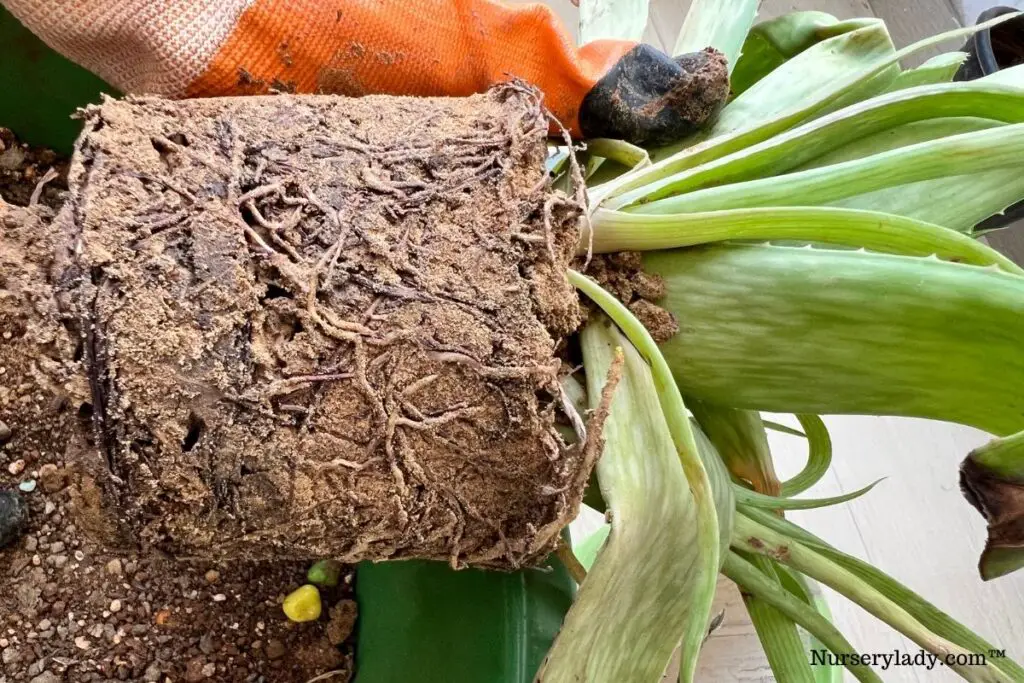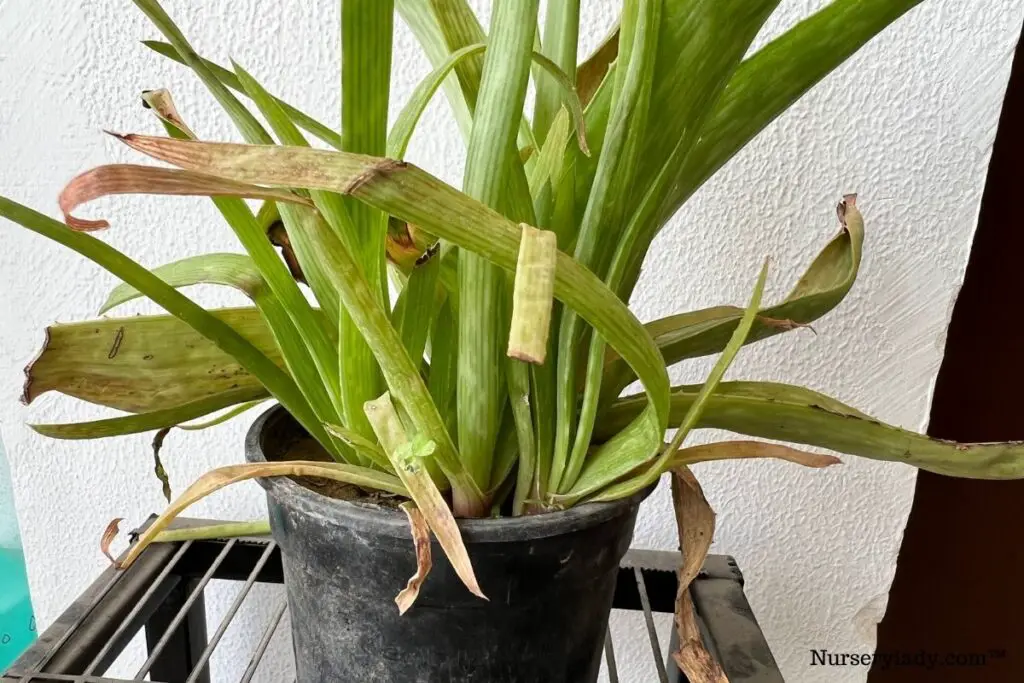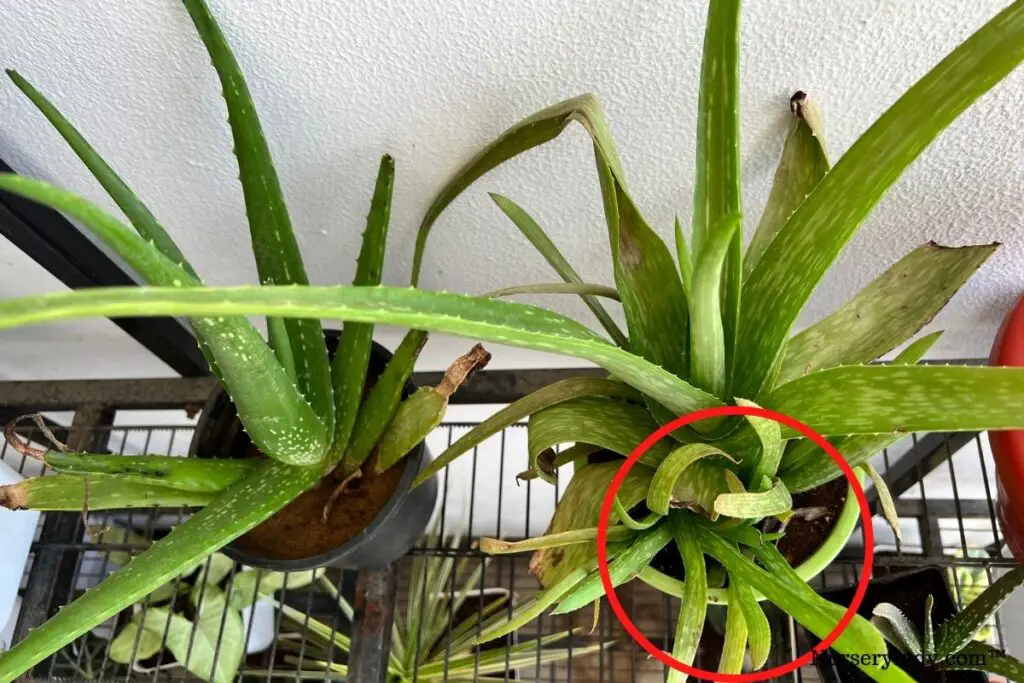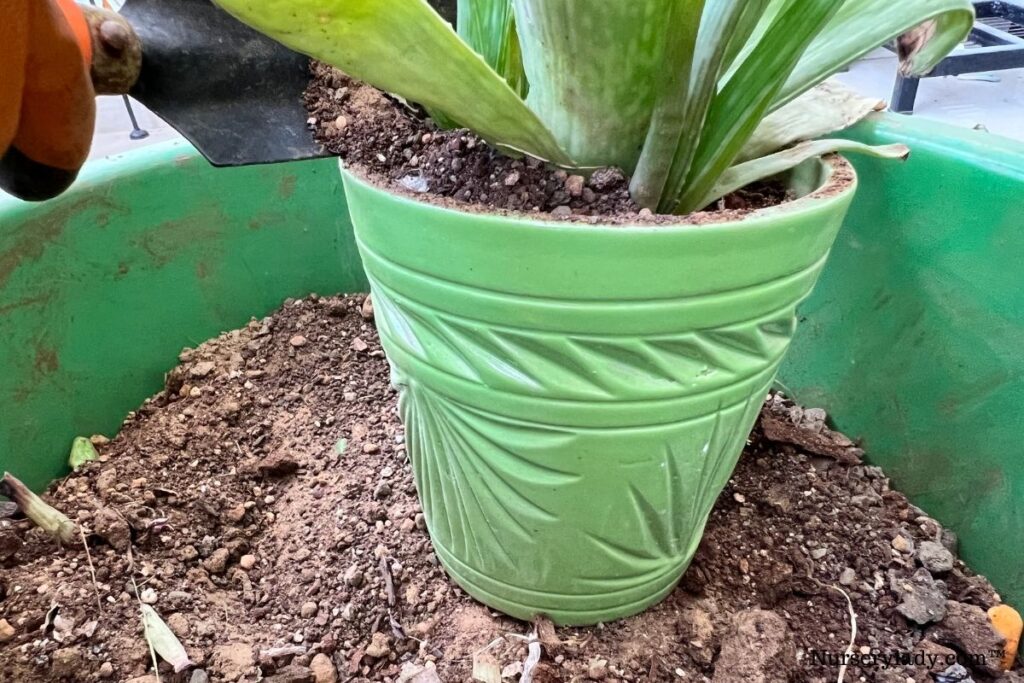Aloe Veras can be grown both in the yards and in pots. However, when it comes to pots, one factor requires consideration. In pots, root-bound becomes a matter of concern. If you ever wondered about the comfort level of Aloe Vera while being root bound, this is the right place to know about it.
Aloe Veras grow well when root-bound in a pot but only to a certain extent. Letting them stay root-bound for a long time will result in dehydration, nutrient deficiency, stunted growth, etc. You must repot your aloe vera plant when the roots start coming out of the soil surface and drainage holes.
To repot them, take a pot that is 1-2 inches bigger than the current one. They will not become root bound too often as they are slow to moderate growers.
Today, I will explain how to identify a root-bound Aloe Vera plant and ways of dealing with it. I will also share the steps of re-potting a root-bound Aloe vera plant.

What does root-bound mean?
When a plant dwells in a small pot, its roots start growing in a circular motion in search of more space to grow and spread.
It is then called a root-bound plant.
If kept like this for a long time, the roots will slowly grow out of the drainage holes.
When a plant shows signs of being root-bound, take it out of the pot.
You will find that the roots have covered the soil by growing in a circular motion.
You will hardly see any soil left at an advanced level.
But, if only a few roots are growing in a circular motion and the soil is still visible, you don’t need to repot the plant immediately.
There are different stages of root-bound.
When the plant shows signs of dehydration and the roots come out of the drainage holes and soil surface, it is time to repot the root-bound plant.
However, there are many more signs of understanding whether the Aloe Vera is root bound or not.
Continue reading to know more.
Does Aloe Vera like to be root-bound?
Aloe Vera will enjoy being slightly root-bound to a certain extent.
Staying root-bound for a very long time will make the plant weak, and, ultimately, the plant will succumb to death.
Since they grow big enough and spread their roots horizontally, they need more space in the pots.
When the plant shows signs of underwatering and roots are coming out of the drainage holes, it indicates that you have kept the plant in such a condition for a long time.
When the roots grow out of the holes, they block the drainage hole at one time.
As a result, the water fails to flow out and results in root rot.
That is why the Aloe Veras won’t enjoy root-bound conditions to such an extent.
The rootbound state seldom occurs to the Aloe Veras in the ground.
They don’t get limited space like the pots.
So, you can worry less about your plants becoming root-bound if Aloe Veras are growing in your yards.
In the pots, whenever you see the signs of root-bound, you must check the roots’ condition, take immediate action, and find out which stage the plant is in.
The next point will tell you how to pinpoint root-bound issues in Aloe Vera.
How do I identify that my Aloe Vera is root-bound?

When the Aloe Veras become too potbound, they give out certain signs.
By observing those signs closely, you can understand root-bound conditions.
Inflated planter
Generally, Aloe Veras are fast growers if compared to other succulents.
But if they are grown indoors, they will grow more slowly than the outdoor Aloes.
When you don’t give a close look at the plant’s growth and keep it in the same pot for years, at one point, the roots will grow too long and fight for more room.
If you don’t repot the plant, the roots will grow so much that ultimately they will try to push the pot from inside.
Due to this, the pot will swell.
It will look like the roots are trying to break the container to get more space.
That is why the planter will look swelled up.
Looking for gardening supplies? We have tested 100's of products before recommending them to you guys. Check out our best pick below:
| Image | Gardening Supplies | Best Price? |
|---|---|---|
 Top
Top Top
Top | Raised Garden Bed Kit | Check On Amazon |
 | XLUX Soil Moisture Meter, Plant Water Monitor, Soil Hygrometer Sensor for Gardening, Farming, Indoor and Outdoor Plants, No Batteries Required | No Results |
 Top
Top Top
Top | 82 Pcs Garden Tools Set and Extra Succulent Tools Set | Check On Amazon |
 | Joeys Garden Expandable Garden Hose with 8 Function Hose Nozzle, Lightweight Anti-Kink Flexible Garden Hoses, Extra Strength Fabric with Double Latex Core, (50 FT, Black) | No Results |
 Top
Top Top
Top | Dual Chamber Compost Tumbler | Check On Amazon |
 Top
Top Top
Top | Sunnyglade Plant Stakes | Check On Amazon |
 Top
Top Top
Top | Organic Cold Pressed Neem Seed Oil | Check On Amazon |
 Top
Top Top
Top | Mighty Mint Gallon :-Insect and Pest Control Peppermint Oil | Check On Amazon |
 Top
Top Top
Top | Scotts DiseaseEx Lawn Fungicide | Check On Amazon |
 Top
Top Top
Top | Jacks Classic 20-20-20 All Purpose Fertilizer | Check On Amazon |
 Top
Top Top
Top | 30,000 Seeds Pollinator Attracting Wildflower Mixture | Check On Amazon |
 Top
Top Top
Top | Survival Vegetable Seeds Garden Kit-Over 16,000 Seeds | Check On Amazon |
Water draining immediately from the drainage holes
When a plant stays root bound for too long, there hardly remains any soil.
When you water the plant, it will immediately flow out of the drainage holes due to a lack of water.
The plant cannot absorb the provided water and remain dehydrated without any soil.
Despite watering properly, they will display signs of underwatering like:
- Yellow or brown leaves
- Droopy leaves
- Brittle root texture
- Dry and thin leaves
- Roots coming out of the drainage holes and soil surface
When the roots need space but cannot get it, they will grow out from some gaps.
It includes the drainage holes.
Despite performing the correct watering, if your Aloe Vera shows dehydrated signs, check the bottom of the pot once.
You will find that the roots are coming out of the drainage holes.
They have found their space to spread.
If you continue to ignore the situation, the soil structure will get destroyed after some time.
The roots will peek out, push themselves outwards, and come out of the soil to spread.
When the roots grow out of the drainage holes, it gets blocked.
Due to this, when you water the plant, it stays in the pot and results in root rot.
No soil will be seen
When the roots start growing from the soil surface, rarely will any soil be left.
Roots will fill up all the gaps left in the pot as they continue growing.
If this condition continues, the roots will start replacing the soil.
You will only find the roots and no soil when you take the Aloe vera out.
What will be the effects of a root-bound Aloe Vera?

Though staying root bound will not affect the Aloe Vera, that should be for a certain time.
Keeping Aloe Veras root-bound for a long time will only result in the deterioration of the plant’s health.
If your plant shows the signs discussed above and you still ignore it, Aloe Vera’s health will deteriorate badly.
Underwatering
When the root-bound condition advances significantly, the soil gets displaced by the roots.
Due to a lack of soil, the Aloe vera cannot absorb the water you provide.
The water roams around the pot and immediately flows out of the drainage holes.
Even with proper watering, the plant will show signs of underwatering.
The leaves turn dry and crispy, brown at the tips and edges, and thin and curly.
The roots will become brittle. If ignored, the plant can end up dying.
Also read: How To Water Aloe Vera Plant? (How often, Summer, Winter)
Overwatering
When the roots grow out of the drainage holes, they block the drainage system.
Due to this, the water you provide remains in the pot at the root portion.
Due to prolonged dampness, the roots become soft and mushy and ultimately start rotting.
Being native to the desert regions, Aloe Vera enjoys dry conditions.
If you keep the plant in such wet conditions, all the roots will get damaged, and the plant will die.
Nutrient deficiency
As mentioned earlier, due to lack of soil, the plant doesn’t receive the water you provide.
Similarly, the plant will also fail to get the nutrients you provide due to a lack of soil.
Without soil, they cannot absorb nutrients.
If you fertilize the plant under such conditions, it will only result in root burn and weakening of the plant.
Also read: Does Aloe Vera Need Fertilizer? (How Much, How Often+Best Pick)
No growth in the plant

When the plant suffers from a root-bound state, they lack watering, nutrition, and space.
Due to the lack of these important requirements, their smooth growth and development get interfered with.
As a result, the plant will first slow down its growth and, over time, stop growing.
The roots will get damaged
When root-bound, the roots grow in a circular motion and then get out from the drainage holes and soil surface.
If kept in such conditions for a long time, the roots will become too compact.
When you try to untangle them by force, they will get injured.
Damaged leaves won’t hurt the plant like the damaged roots.
The plant’s life depends on the roots.
Without a healthy root, the plant would neither stay healthy nor live long.
That is why it is essential to re-pot Aloes within the right time.
The plant will die
Many gardeners don’t give much attention to the Aloe Veras.
With enough light, water, and temperature, they need many other requirements, and repotting is one of them.
Your Aloe vera will die after suffering if you continue to ignore it despite seeing the signs.
How to save a root-bound Aloe vera?

The best way to save a root-bound Aloe vera is by repotting it to a new pot.
Choose a pot 1-2 inches bigger than the old pot and 1/3rd bigger than the plant size.
They enjoy some extra space because their roots love to spread horizontally.
Choose a shallow and wide pot rather than a deep one.
Tools required for repotting:
- Gloves
- Disinfected knife
- A new container
- Your plant
- Garden tools like forks, spades, or trowels to loosen the soil and take the plant out
- Ideal soil mix
Steps to re-pot Aloe Veras
- Water your Aloe vera 2-3 days before repotting. It will help to loosen the soil. You can also squeeze the sides of the pot if it is plastic.
- Take the plant out of the pot slowly. Don’t pull the plant forcefully. It can damage and kill them.
- If you find any offsets, separate them using a knife. Disinfect the knife with rubbing alcohol before and after using it.
- Remove the maximum amount of dirt from the root portion. Use a brush instead of water to clean the roots. You might find some gel while cleaning. It’s fine.
- Now, let the roots heal in a bright and dry spot for some days. It will keep the plant from suffering infections.
- Add some perlite or sand if you use standard potting soil. It will improve the drainage. You can read our soil article for finding suitable soil for Aloe. Or, simply use succulent and cactus mix, ½ parts each.
- Now, fill half of the new pot with the soil.
- Make a hole in the center for one single plant or sideways for multiple plants.
- After placing the Aloe in that hole, cover the root ball with the remaining soil mix. Don’t cover the leaves. Press soil around to settle it down.
- Keep the pot under a partially shady area for a couple of weeks and let them heal. Direct sunlight can harm them during this time.
- Water after a couple of days. Since they can store water in the leaves, not watering will not harm them.
- Once they are healed and well-established after a couple of weeks, expose them to sunlight gradually and water sparingly, every 2-3 weeks.
Also read:
- What Type Of Soil For Aloe Vera Plant? (+Ideal Soil Mix)
- What Pot Is Best For Aloe Vera Plant? (Pot Type, Size & More)
Pruning the roots
Pruning the roots is another way to save a root-bound Aloe vera plant.
If you don’t want to replace the pot, you can save the root-bound plant by detangling the roots and pruning the long thin roots.
- Slowly separate the circular roots. Use a knife to cut them off if they are too intertwined. Also, cut off the long thin roots in the shape of the other roots.
- Wait for some days to let the plant heal. It will ensure the prevention of infections.
- After that, plant them back in the old pot with fresh soil.
- Wait for some weeks to water the plant. Since they store water, immediate watering is not required.
- Keep them under a partially shady area.
Final thoughts
A slight root-bound state for some time is fine for Aloe Vera. But, if they stay like this for a long time, it will only make them unhealthy and weak. Generally, you should repot Aloe Veras after every 1-2 years.
Never ignore repotting the succulent. If you don’t want to replace the present pot, for now, you can trim the roots to treat the root-bound condition. But, ultimately, your plant will need a new pot once it grows big.
Always take a pot 1-2 inches bigger than the current one and 1/3rd bigger than the plant. This extra room will keep the roots healthy, let them spread well, and avoid frequent root-bound conditions.
Reference: NCBI, New York Botanical Garden, University of New Hampshire, University of Florida, Wikipedia.
